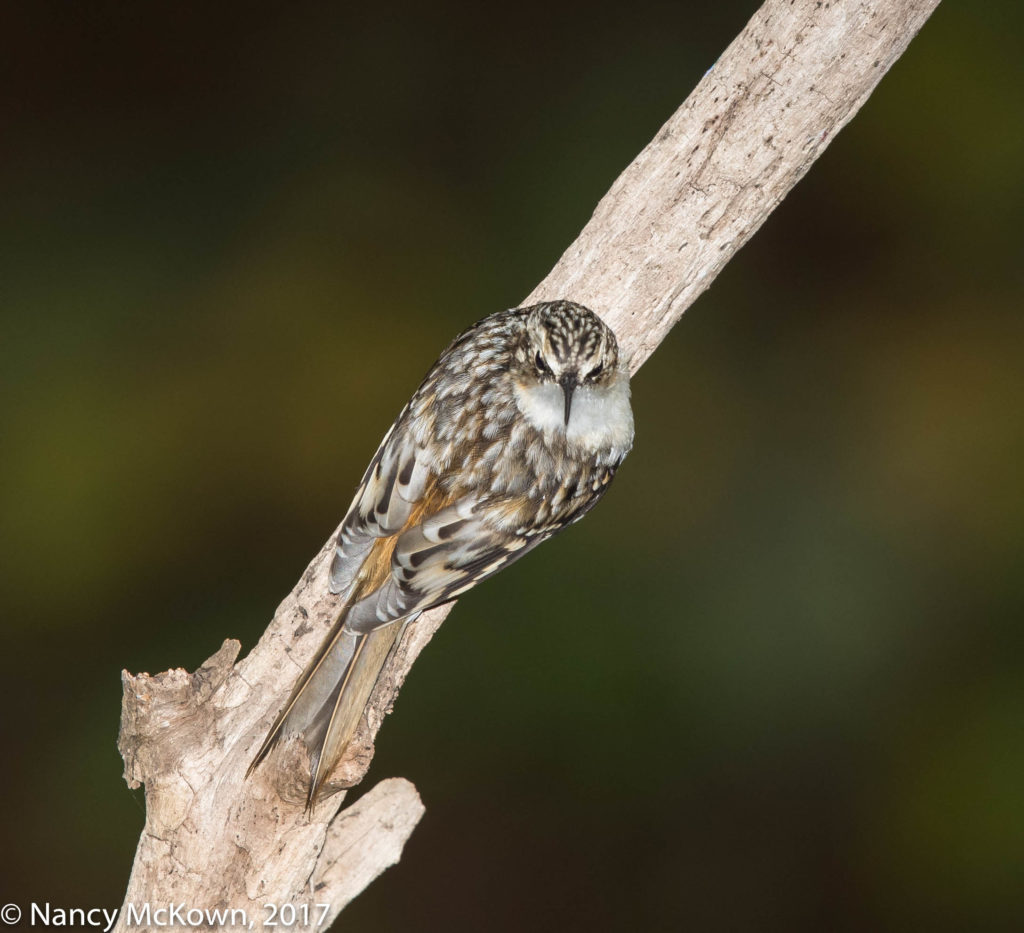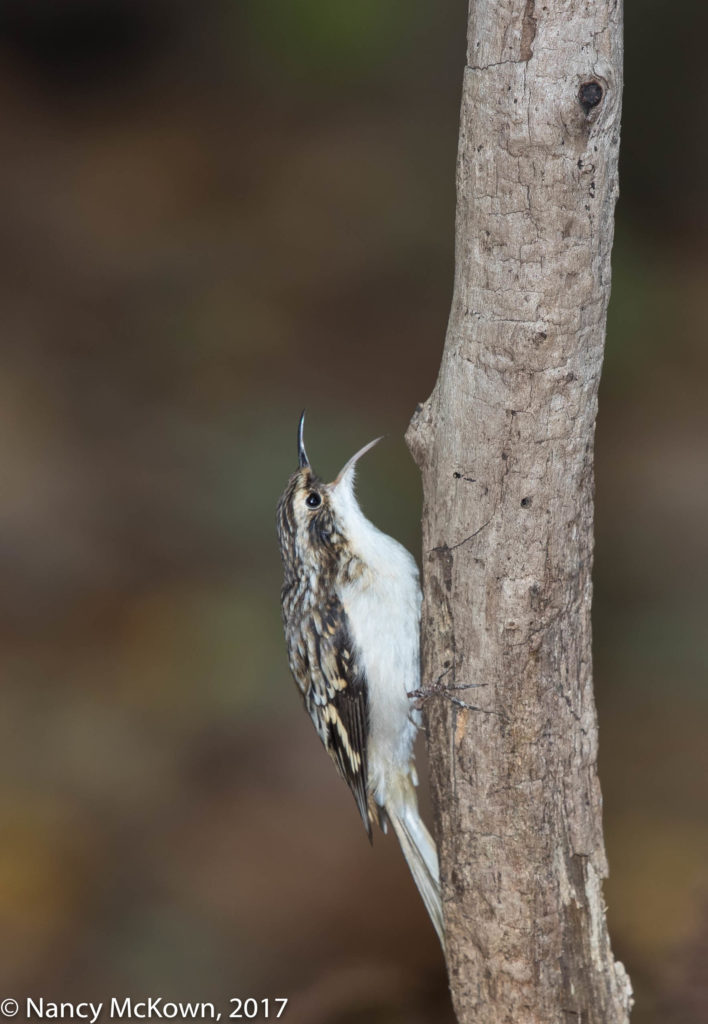Photographing a Brown Creeper
The treasure trove of thrushes, warblers, finches, sparrows, and juncos are so obviously gone from our yard now- no doubt embarking on their seasonal cycles. But the tiny Brown Creepers are still here. They forage year-round in our woods (whether they are the same birds or newly arrived migrators I do not know). As they scootch up a heavily crusted dark tree trunk, they are amply camouflaged. The beautiful patterns and colors of their plumage are concealed…looking more mottled as they blend against the mature, thick bark. It’s only when I am able to capture them atop a lighter colored perch that the intricate designs and patterns of the plumage show themselves.
Similar to woodpeckers, Brown Creepers use their tails as props while hitching upward and spiraling in jerky motions from the bottom of the tree to the top to probe for small arthropods in the crevices of the bark. They even build their nests under loose pieces of tree bark.
Brown Creeper
ISO400; f/8; 1/250 Second
Objecting to Someone
In his Path
Crop Sensor Decision
When thoughts of new birds are not dancing in my head, my mind wanders to the joy of getting my hands around new and fanciful electronic toys.
I’m looking to replace my Canon 7D Mark II DSLR camera. It’s been a reliable camera, but over the years I’ve become partial to full sensor digital SLR cameras. Three years ago, I bought the 7D Mark II cropped sensor camera to take advantage of the increased focal length:
- Attach a 500mm lens to a Canon 7D Mark II with 1.6 cropped sensor and your lens is effectively transformed into an 800 mm lens (1.6 x 500).
- Attach a Canon 1.4x III telephoto extender to the 500mm lens and the magnification becomes 1120mm (800 x 1.4).
- Attach a Canon 2.0x III telephoto extender to the 500mm lens and the magnification becomes 1600mm (800 x 2.0).
A 1600mm focal length opens a lot of doors for bird photographers.

ISO400; f/8; 1/250 Second
I like the intricate feather patterns
and colors on his back plumage.
Made more obvious by the
light colored perch.
Impact of Camera Sensor Size
Theoretically, when comparing Canon’s modern, high quality DSLR camera sensors of different sizes, and using similar lighting and distance parameters and similar megapixel counts, the full frame sensor (because it is twice the size of the cropped sensor and brings in more light) will likely deliver a broader dynamic range and better quality low light resolution (less noise) than the cropped sensor will.
Over the years I’ve learned that the difference in quality between Canon’s high end full sized sensor and cropped sensor is pretty small when the subject is well within range of the telephoto lens. (NOTE: To capture tack sharp images, there’s no substitution for getting as close as possible to your subject.)
Distance Matters
If the subject is too far away, and you are unable to (mostly) fill the frame with the bird and its surroundings, you are then forced to zoom-in dramatically during post processing. Digital images consist of pixels/dots. You enlarge those dots whenever you zoom-in, more so if you are zooming into a relatively small component of the photo. The more you zoom, the more the image degrades, causing image detail and quality to suffer. A larger sensor provides more megapixels, causing less image degradation when zooming. Essentially, when you pay for 30.4 million (or however many) pixels on a larger sensor- you gain an advantage in cropping.
Exploring the 5D Mark IV
Why buy this new DSLR camera? (NOTE: It’s not a good investment, financially.) I have owned two of the Canon 5D series (II and III) and liked them a lot. Not unexpectedly, this latest 5D Mark IV is purported to have superior image quality and speed. But the main reason I am interested in this camera is because the full frame sensor (36.0mm x 24.0mm) records a hefty 30.4 Megapixels- quite a bit more than the Canon 7D Mark II (20.2MP) or the Canon Flagship, 1DX Mark II-(20.2MP)- but not as much as Canon’s megapixel monsters–the Canon 5 DS cameras with sensors holding 50.6 Megapixels.
Advantages of More Megapixels
- The main advantage of having a DSLR camera with densely packed megapixels is that you can capture an enormous amount of detail. (The 50.6 monster megapixel cameras would definitely appeal to specialized markets; those photographers who crave detail and are equipped to incorporate artificial light when needed to keep ISO levels low.)
- Distance between the lens and subject would be less of an issue because the high megapixel count would give photographers more freedom to crop (in post processing) without denigrating the image too much.
- High quality enlarged prints would be possible.
Disadvantages of More Megapixels
- The higher the megapixel count on the sensor, the more you sacrifice low light performance. Canon introduced two monster mega pixel cameras (Canon 5DS)in 2015. I seriously considered buying one of these cameras, but the mediocre light gathering potential (ISO recommended range = 100-6400) of the sensors put me off. At that time I relied exclusively on natural light and did not attach a flash to my cameras.
- Photographers would not be able to see the high level of detail on most computer monitors.
- The computer processing power and the hard drive storage needed to process 30.4 million pixels per photo is massive?
- Despite the in-camera Digit 6+ processor improvements, the Canon 5D Mark IV will use more power and take longer to process, store and transfer all that image data.
- Bigger compact flash and SD memory cards to accommodate the massive storage requirements will set photographers back a bit. At this writing, a SanDisk 128GB Extreme Pro CompactFlash Card, with UDMA 7 Speed Up To 160MB/s, now costs $149… and slowly coming down.
Another Door Opened
I would like a camera with a CMOS sensor that delivers not only outstanding detail and excellent low light performance, but also provides substantial pixels so that the image stays sharp when I need to zoom in post processing. I think the Canon 5D Mark IV will do those things.









